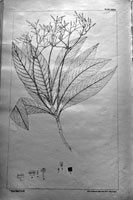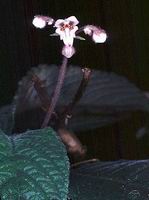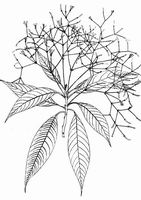
Commelynaceae et Cyrtandraceae Bengalenses 118 (1874), t. 85.
Full name and orig. publication: Boeica C.B.Clarke, Commelyn. Cyrtandr. bengal. 118, t. 87 (1874) ("Baeica").
Etymology: A modification of the generic name Boea.
Synonym: Boeicopsis H.W.Li (1982).
Infrafamilial position: Didymocarpoid Gesneriaceae - "Basal Asiatic genera" (Weber 2004).
Description: (Sub)shrubs or perennial rhizomatous herbs. Leaves alternate, spaced along stem or tufted at apex or rarely forming a basal rosette; petiolate, lamina (ob)ovate to elliptical, base cuneate or attenuate, glabrous to densely woolly. Cymes axillary, lax or dense, 1- to many-flowered. Sepals free or fused halfway. Corolla campanulate or flat-faced, limb slightly zygomorphic, upper lip 2-lobed, lower lip 3-lobed, lobes (sub)equal, rounded or acute. Stamens 4, inserted near corolla base, filaments short, anthers large, free, basifixed, thecae subparallel, apically confluent; longitudinally, poricidally or transversely dehiscent; staminode present. Nectary ring-like or lacking. Ovary ovoid or conical, with parietal placentae; stigma capitate. Capsule oblong to linear, longer than calyx, straight, loculicidally and (always?) septicidally dehiscent, style base persistent.
Chromosome number: 2n = ± 22 (B. brachyandra Ridl.).
Species number: About 12.
Species names (incl. publication and synonyms): See Skog, L.E. & J.K. Boggan. 2005: World checklist of Gesneriaceae: http://persoon.si.edu/Gesneriaceae/Checklist.
Type species: Boeica fulva C.B.Clarke
Distribution: Bhutan, S China (7 spp.; Yunnan, Guangxi, Hong Kong, Xiang, ), N & NE India, Myanmar, N Vietnam, NW Malaya.
Ecology: In shady and damp places and on humid rocks in forests, 200 - 1400m.
Notes: The genus is closely allied to Leptoboea, differing mainly in the alternate leaf arrangement. It is apparently heterogeneous and in need of a critical revision. The inclusion of the two Malayan species and B. guileana B.L.Burtt (S China) into Boeica is doubtful. These plants differ in habit and corolla shape considerably from the Indian-Burmese species around B. filiformis. Wang (1990) refers the Chinese spp. to two sections: (1) sect. Boeica, (2) sect. Boeicopsis (H.W.Li) K.Y.Pan.
Selected references: Burtt, Notes Roy. Bot. Gard. Edinburgh 35: 369-374 (1976), notes, new sp.; Li, Acta Bot. Yunnan. 43(3): 241-247 (1982); Wang & Pan, Bull. Bot. Res. 2: 122 (1982), new sp.; Wang et al. in Wu & Raven (eds.), Fl. China 18: 287-289 (1998), reg. rev.; Hilliard, in Grierson & Long, Fl. Bhutan 2(3): 1324 (2001), reg. rev.;Burtt, Thai Forest Bull. (Botany) 29: 81-109 (2001), annot. checklist, new spp. (Thailand).
Bibliography: See Skog, L.E. & J.K. Boggan. 2005. Bibliography of the Gesneriaceae. 2nd edition: http://persoon.si.edu/Gesneriaceae/Bibliography.
Illustrations:
 |
Boeica fulva C.B.Clarke,
type species
Commelynaceae et Cyrtandraceae Bengalenses 118 (1874), t. 85. |
 |
Boeica ferruginea Drake China, sine loc., phot. M. Möller (no. MMO 01-182) |
 |
Boeica filiformis C.B.Clarke
C.B.Clarke, Commelyn. Cyrtandr. Beng. t. 87 (1874), original illustration |
last modified: 2008-12-19